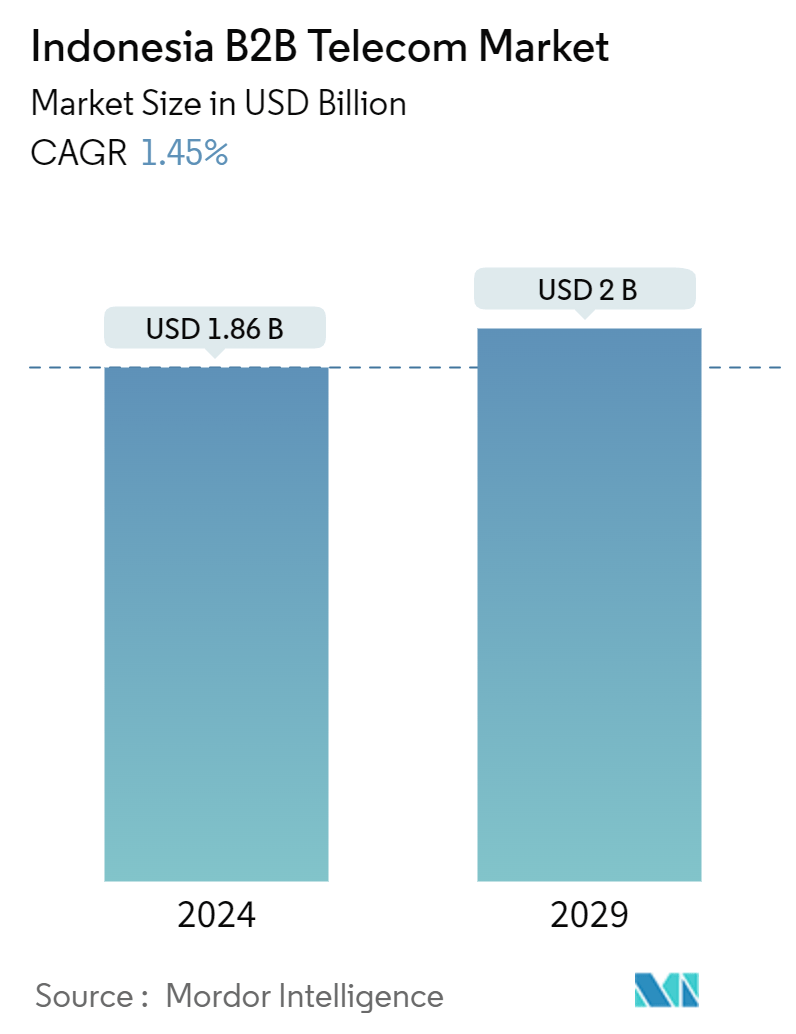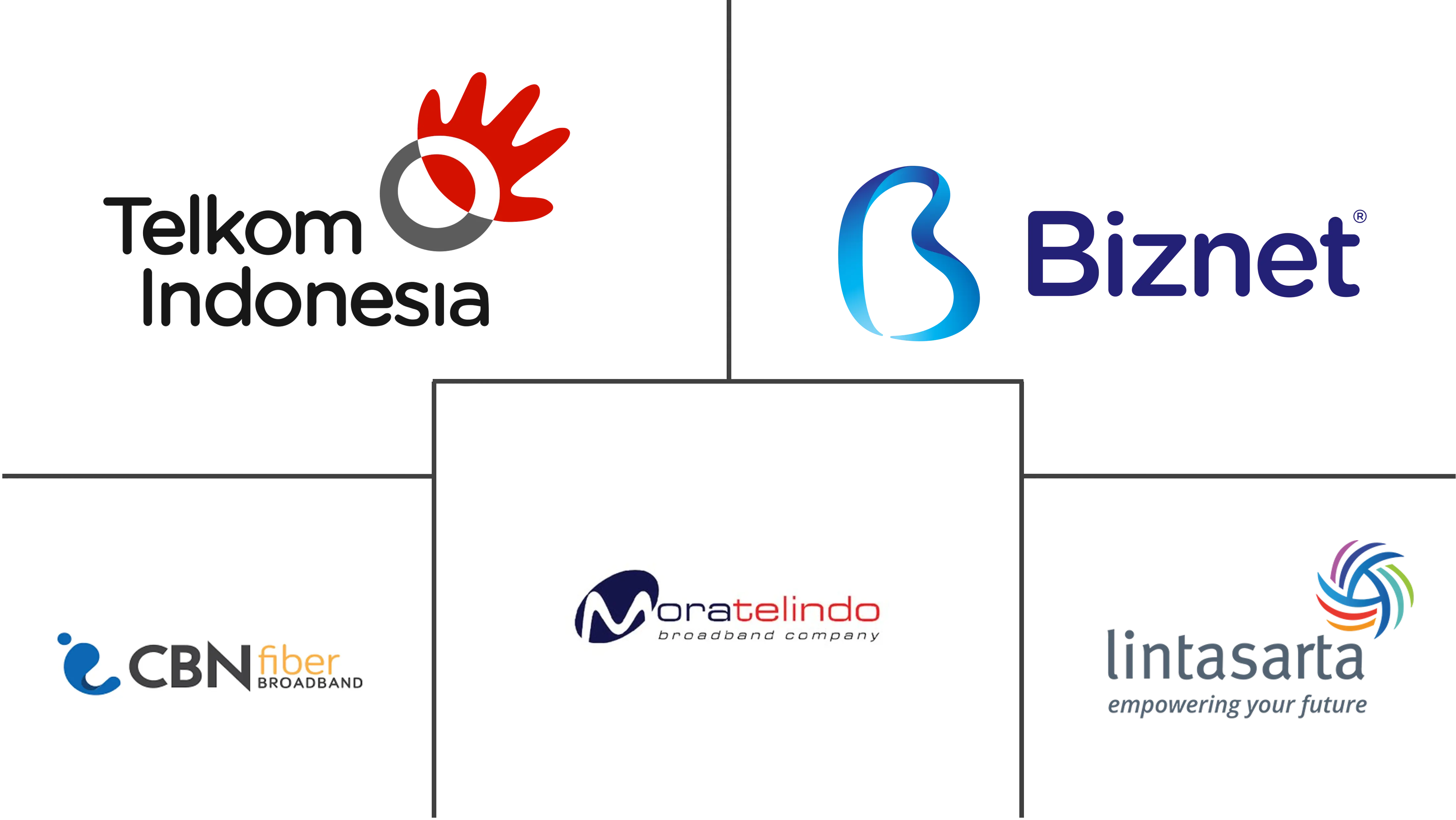Market Size of Indonesia B2B Telecom Industry

| Study Period | 2022 - 2029 |
| Base Year For Estimation | 2023 |
| Market Size (2024) | USD 1.86 Billion |
| Market Size (2029) | USD 2 Billion |
| CAGR (2024 - 2029) | 1.45 % |
| Market Concentration | High |
Major Players
*Disclaimer: Major Players sorted in no particular order |
Indonesia B2B Telecom Market Analysis
The Indonesia B2B Telecom Market size is estimated at USD 1.86 billion in 2024, and is expected to reach USD 2 billion by 2029, growing at a CAGR of 1.45% during the forecast period (2024-2029).
The market is continuously expanding, fueled by a rising appetite for high-speed data, dependable connectivity, and cutting-edge communication solutions. The integration of 5G technology is reshaping the B2B telecom landscape, facilitating swifter data transfers, seamless IoT integration, and heightened productivity. Companies leverage these telecommunication platforms to enhance a company's industry visibility and pinpoint networking prospects, further fueling the demand for B2B telecommunications.
- The B2B telecom market in Indonesia is witnessing a surge, propelled by the increasing adoption of IoT and a heightened demand for B2B telecommunication services from corporate and government entities. Furthermore, as Indonesia experiences a wave of industrialization and urbanization, these trends are expected to bolster the market's growth further.
- The cloud service sector is expected to grow in Indonesia. Digital skill programs and cloud adoption through digital native businesses are the main forces driving B2B communication, with increasing traction from media players, financial institutions, retailers, and large family-run conglomerates.
- The Indonesia Digital Roadmap for 2021-2024 highlights key sectors, including taxation, logistics, and cybersecurity. However, a significant challenge looms large, which is Indonesia's inadequate telecommunications and internet infrastructure. Overcoming this hurdle necessitates a strategic focus on expanding internet coverage and boosting connection speeds. These efforts are not merely advantageous but rather crucial for driving market growth in the region.
- One of the primary hurdles hindering innovation and technology adoption in Indonesia's automotive, electronics, food and beverage, textile, and footwear sectors is the limited access to information. Given the nation's heavy reliance on these industries, there is a clear opportunity for Indonesia to spearhead programs aimed at enhancing firms' grasp of cutting-edge technologies and the associated business advantages. As these industries pivot towards digitalization, embracing technologies such as cloud computing and IoT, they are poised to significantly influence the B2B telecom and communication market.
- The immediate impact of the COVID-19 pandemic on the B2B telecom sector was an increase in traffic flow from connections between data centers to homes, driving upgrades. It also resulted in increased demand for support as companies transitioned to tech-enabled models. However, even after the pandemic, the work-from-home culture and focus on digital and online presence by companies to cater to their digitally educated customers, such as in the case of BFSI companies, and accelerated demand for unified communications (UC) solutions, including complete migration from traditional to VoIP, is expected to help drive the B2B telecom market.
Indonesia B2B Telecom Industry Segmentation
B2B telecommunication providers operate systems that facilitate the transmission of data, text, sound, voice, and video, enabling direct business-to-business communication. Additionally, marketers leverage these telecommunication platforms to enhance a company's industry visibility and pinpoint networking prospects, further fueling the demand for B2B telecommunications.
The report covers Indonesian B2B telecom companies, and the market is segmented by connectivity type (mobile connectivity, fixed connectivity [covers DSL, FTTP/B, cable modem, FWA]) and size of enterprises (small and medium-sized enterprises [SMEs], large enterprises).
The report offers market sizes and forecasts in value (USD) for all the above segments.
| By Connectivity Type | |
| Mobile Connectivity | |
| Fixed Connectivity (Covers DSL, FTTP/B, Cable Modem, FWA) |
| By Size of Enterprises | |
| Small and Medium-sized Enterprises (SMEs) | |
| Large Enterprises |
Indonesia B2B Telecom Market Size Summary
The Indonesian B2B telecom market is experiencing significant growth, driven by the increasing demand for high-speed data and reliable connectivity solutions. The integration of 5G technology is a key factor reshaping the landscape, enabling faster data transfers and seamless IoT integration. This technological advancement is crucial for enhancing productivity and expanding networking opportunities for businesses. The market's expansion is further supported by the adoption of IoT and the digital transformation of various sectors, including manufacturing and smart cities. Government initiatives like 'Making Indonesia 4.0' and the development of smart cities are fostering industrial IoT adoption, which in turn is propelling the demand for B2B telecom services.
Despite the promising growth, the market faces challenges such as inadequate telecommunications infrastructure and limited access to information in critical industries. However, strategic efforts to expand internet coverage and improve connection speeds are essential for overcoming these hurdles. The COVID-19 pandemic has also accelerated the shift towards digital and online presence, increasing the demand for unified communications solutions. Major players in the market, including Telkom Indonesia and Indosat Ooredoo, are actively enhancing their service offerings through partnerships and technological innovations. These developments, coupled with the government's digital roadmap, position Indonesia's B2B telecom market for continued expansion and competitiveness in the region.
Indonesia B2B Telecom Market Size - Table of Contents
-
1. MARKET INSIGHTS
-
1.1 Market Overview
-
1.2 Analysis of Macroeconomic Scenarios (Recession, Russia-Ukraine Crisis, etc.)
-
-
2. MARKET SEGMENTATION
-
2.1 By Connectivity Type
-
2.1.1 Mobile Connectivity
-
2.1.2 Fixed Connectivity (Covers DSL, FTTP/B, Cable Modem, FWA)
-
-
2.2 By Size of Enterprises
-
2.2.1 Small and Medium-sized Enterprises (SMEs)
-
2.2.2 Large Enterprises
-
-
Indonesia B2B Telecom Market Size FAQs
How big is the Indonesia B2B Telecom Market?
The Indonesia B2B Telecom Market size is expected to reach USD 1.86 billion in 2024 and grow at a CAGR of 1.45% to reach USD 2 billion by 2029.
What is the current Indonesia B2B Telecom Market size?
In 2024, the Indonesia B2B Telecom Market size is expected to reach USD 1.86 billion.

